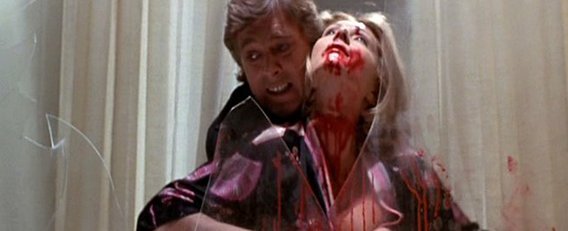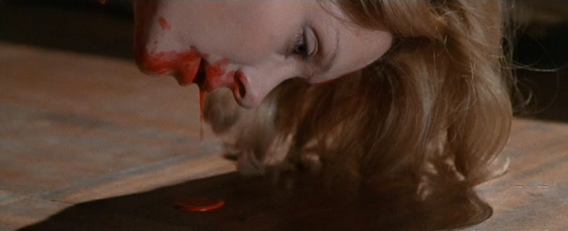
1975’s Profondo rosso (aka Deep Red) saw Italian filmmaker Dario Argento return to the giallo format that he had desperately tried to distance himself from after a string of successful murder mysteries had threatened to leave him typecast as a horror director. One of those attempts, a disappointing comedy drama entitled Le cinque giornate (The Five Days of Milan), had been a disillusioning experience and Argento was forced to contemplate his next move very carefully. Whilst his early work had brought him great acclaim in his native country, his efforts at taking his career in a new direction had been a disaster and his fanbase, desperate to see him recycle the same formula over and over again, demanded that he returned to the giallo genre which he had in some small part helped to perfect. But Argento was conscious not to simply repeat his previous success by plagiarising his own work and began toying with new ideas that would help add a fresh element to the template and help raise the bar on Italian thrillers.
Dario Argento had made his directorial debut in 1970 with the critically acclaimed whodunnit L’uccello dalle piume di cristallo (The Bird with the Crystal Plumage), a loose adaptation of Fredric Brown’s 1949 novel The Screaming Mimi, focusing on an American writer vacationing in Rome who becomes witness to an attempted murder and, convinced that he unknowingly saw a vital clue, launches his own investigation, eventually attracting the attention of the killer. The surprise success prompted its investors to suggest that Argento produce a similar movie once again, resulting in Il gatto a nove code (Cat O’Nine Tails), a complex and atmospheric thriller that failed to gain a similar response to its predecessor. His third effort, 4 mosche di velluto grigio (Four Flies on Grey Velvet), remains his most underrated film and was unavailable on home video until earlier this year. After three attempts at producing giallos, he had finally perfected the formula and by early 1974 the decision was made to make a fourth.
Argento would once again utilise many of the narrative tools with which he had put into practice with his so-called ‘Animal trilogy‘ (a term coined not by the director himself but by critics due to the three films containing ‘Bird,’ ‘Cat‘ and ‘Flies‘ in their respective titles). As with his debut, Argento’s new story would centre around a tourist who witnesses the brutal slaying of an innocent woman, only to become determined to uncover the truth. The killer would also wear black gloves to conceal his/her identity, a tool first practiced in Mario Bava’s early giallo Sei donne per l’assassino (Blood and Black Lace) over a decade earlier. One additional aspect to the formula was Argento’s decision to add supernatural undertones, with the tale’s first victim being a respected psychic who had sensed the presence of a murderer in the audience where she had been a guest demonstrating her gift.
To develop his story, Argento retreated to an old house that his parents owned on the outskirts of Rome, where he could work undisturbed without the distractions of company of even a telephone. The isolation of the location would inspire a claustrophobic element to the story, with each of the central protagonists being very much alone emotionally. The screenplay itself was written in collaboration with Bernardino Zapponi, a friend of auteur Federico Fellini whom he had first met in 1967 after the director had read the author’s book Gobal. Deep Red would mark the only time that Argento and Zapponi would work on a script together, although their working relationship had been enjoyable and productive. Their story would mix elements of Argento’s earlier work with fantasy, along with a homosexual subtext (which Four Flies on Grey Velvet had also flirted with).
Deep Red begins at the European Congress On Parapsychology in Rome, where Lithuania medium Helga Ulman has been invited to display her extraordinary talents to a room full of skeptics. Midway through her demonstration, she received images of a murder and becomes convinced that the culprit is present in the audience. Later that evening, she is brutally slain in her apartment, just as her neighbour, British music teacher Marcus Daly, is returning home. Rushing to her aid, the young woman is dead but Marcus is convinced that something seems out of place and begins to obsess over the event. He soon makes the acquaintance of ambitious journalist Gianna Brezzi and begins an investigation which will lead to the discovery of an unpleasant truth. Whilst the basic story is very much in the vein of The Bird With the Crystal Plumage, the tone and atmosphere is more geared towards the supernatural.
Despite Argento’s growing dislike for actors, due to their idiosyncrasies, the casting for Deep Red was a relatively simple affair. For the central role of Marcus, the director approached thirty-two year old Surrey-born performer David Hemmings, whom Argento had seen in Michaelangelo Antonioni’s 1966 classic Blow Up. Argento’s experiences with his lead actors had varied from one extreme to another. Whilst Four Flies on Grey Velvet‘s Michael Brandon had become a close friend, The Bird With the Crystal Plumage‘s Tony Musante had proved to be extremely temperamental and awkward. The one casting decision that would have a profound effect on the rest of Argento’s life was with the actress that he had chosen for the role of the sidekick reporter. Having first seen her in Elio Petri’s La proprietà non è più un furto (Property Is No Longer a Theft), the director had immediately become enthralled by its young co-star, Daria Nicolodi. The pair would later work on several projects together, with Nicolodi even helping to write two of his most acclaimed works, although perhaps their greatest creation was their daughter, Asia, who was born on September 20 1975.
Principal photography commenced in Turin on September 9 1974 for approximately sixteen weeks, with the interior scenes shot at De Paolis Incir Studios in Rome (where he would later to return to with his 1987 effort Opera). Argento had begun to experiment with inventive camerawork, which was displayed earlier on in the movie with scene in which the camera passes across a floor through various technicolour objects lying scattered around Helga’s apartment. One of Deep Red‘s greatest assets was its score, which was to become a major issue for the director during the shoot. Having experienced a disappointing collaboration with renowned composer Ennio Morricone during the making of Four Flies on Grey Velvet, Argento had hoped to hire the serviced of respected rock group Deep Purple. For his latest venture, he had drafted in The Five Days of Milan‘s Giorgio Gaslini, whom the director would soon discover would have a completely different take on what the score of the movie should be. After travelling to London to meet with Pink Floyd, Argento would happen across a demo tape by unknown prog rock band Goblin and immediately decided that they would be perfect for the film.
Deep Red was released theatrically in Italy on March 7 1975 as Profondo rosso and became a major success, with many critics declaring the film as Argento’s best work. In America, where it debuted on June 9 in New York, a full twenty-two minutes were exorcised from the film, removing various sub-plots and scenes which the distributors felt flowed down the pace. This heavily butchered version would also come to be known as The Hatchet Murders whilst, in a rather bizarre move, would later be released in other regions as Suspiria Part 2, despite being released two years before his 1977 masterpiece. Deep Red would become the movie which all his subsequent work would be measured to, and the film would mark lifelong collaborations with Nicolodi, Goblin (and especially keyboardist Claudio Simonetti), editor Franco Fraticelli and special effects artist Germano Natali. Over thirty years later and Deep Red still remains, alongside Suspiria, his most revered and referenced work.


5 Responses to SPAGHETTI SLASHERS – Deep Red